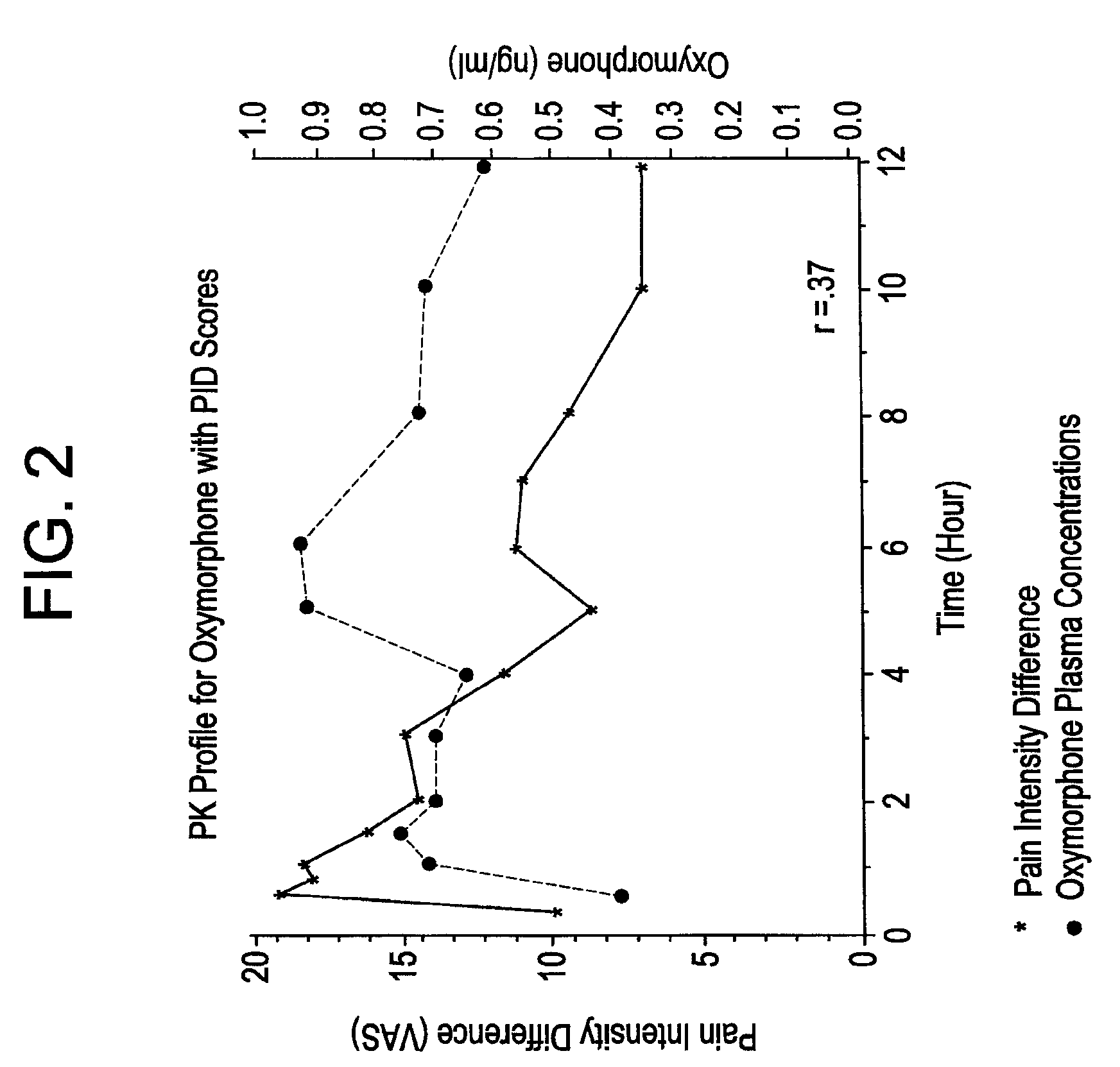Method of Treating Pain Utilizing Controlled Release Oxymorphone Pharmaceutical Compositions and Instruction on Dosing for Renal Impairment
- Summary
- Abstract
- Description
- Claims
- Application Information
AI Technical Summary
Benefits of technology
Problems solved by technology
Method used
Image
Examples
example 1
[0069]Two controlled release delivery systems are prepared by dry blending xanthan gum, locust bean gum, calcium sulfate dehydrate, and dextrose in a high speed mixed / granulator for 3 minutes. A slurry is prepared by mixing ethyl cellulose with alcohol. While running choppers / impellers, the slurry is added to the dry blended mixture, and granulated for another 3 minutes. The granulation is then dried to a LOD (loss on drying) of less than about 10% by weight. The granulation is then milled using 20 mesh screen. The relative quantities of the ingredients are listed in the table below.
TABLE 1Controlled Release Delivery SystemFormulation 1Formulation 2Excipient(%)(%)Locust Bean Gum, FCC 25.030.0Xanthan Gum, NF 25.030.0Dextrose, USP 35.040.0Calcium Sulfate Dihydrate, NF 10.00.0Ethylcellulose, NF 5.00.0Alcohol, SD3A (Anhydrous) (10)1(20.0)1Total 100.0100.0
[0070]A series of tablets containing different amounts of oxymorphone hydrochloride were prepared using the controlled release de...
examples 2 , 3 and 4
Examples 2, 3 and 4
[0071]Two batches of 20 mg tablets were prepared as described above, using the controlled release delivery system of Formulation 1. One batch was formulated to provide relatively fast controlled release, the other batch was formulated to provide relatively slow controlled release. Compositions of the tablets are shown in the following table.
TABLE 3Slow and Fast Release CompositionsExample 2Example 3Example 4IngredientsSlow (mg)Fast (mg)Fast (mg)Oxymorphone HCl, USP202020Controlled Release Delivery System360160160Silicified Microcrystalline Cellulose,202020NFSodium stearyl fumarate, NF422Total weight404202202Coating (color or clear)12129
[0072]The tablets of Examples 2, 3, and 4 were tested for in vitro release rate according to USP Procedure Drug Release U.S. Pat. No. 23. Release rate is a critical variable in attempting to control the blood plasma levels of oxymorphone and 6-hydroxyoxymorphone in a patient. Results are shown in the following Table 4.
TABLE 4Release...
example 5
[0138]Study Objectives
[0139]The objective of this study was to determine the effect of renal impairment on the pharmacokinetics and metabolism of oxymorphone following a single oral dose of EN3202 (oxymorphone HCl extended-release) tablets.
[0140]Methods
[0141]Clinical Study Design and Conduct
[0142]This study employed a single-dose, parallel-group study design in 24 subjects with chronic renal insufficiency (8 with mild renal impairment, creatinine clearance=51-80 mL / min; 8 with moderate renal impairment, creatinine clearance
[0143]=30-50 mL / min; and 8 with severe renal impairment, creatinine clearance80 mL / min). Attempts were made to match controls with the renal impaired patients with respect to age, gender, and weight. Each subject received a single 20 mg dose of EN3202 (oxymorphone ER). The oxymorphone ER tablets administered were according to the now-available commercial formula of Opana® 20 mg strength, which also contains the inactive ingredients hypromellose, iron oxide black, ...
PUM
| Property | Measurement | Unit |
|---|---|---|
| Time | aaaaa | aaaaa |
| Bioavailability | aaaaa | aaaaa |
| Bioavailability | aaaaa | aaaaa |
Abstract
Description
Claims
Application Information
 Login to View More
Login to View More - R&D
- Intellectual Property
- Life Sciences
- Materials
- Tech Scout
- Unparalleled Data Quality
- Higher Quality Content
- 60% Fewer Hallucinations
Browse by: Latest US Patents, China's latest patents, Technical Efficacy Thesaurus, Application Domain, Technology Topic, Popular Technical Reports.
© 2025 PatSnap. All rights reserved.Legal|Privacy policy|Modern Slavery Act Transparency Statement|Sitemap|About US| Contact US: help@patsnap.com



